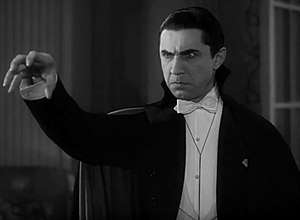Horror icon
A horror icon is a person or fictional character that is considered to be significant to one or more genres of horror such as film, literature, or video games.[1][2] Examples of people considered to be horror icons include directors Stephen King,[3] Kiyoshi Kurosawa, Roger Corman and Wes Craven,[4] and actors Vincent Price,[5] Barbara Steele,[6] Lon Chaney and Lon Chaney Jr., Boris Karloff, Bela Lugosi, Robert Englund, Tony Todd, Tim Curry, Angus Scrimm, Brad Dourif and Christopher Lee.[7] Fictional horror icon characters include such as Dracula, Gill-man, Frankenstein's monster, Michael Myers, Ghostface, Freddy Krueger, Jason Voorhees, Chucky, Candyman, Hannibal Lecter, Leatherface, Pennywise the Dancing Clown, Pinhead,[8], The Mummy, [1] and Jigsaw (Saw character).
History
Pre 1900s
Examples of early horror icons began with the Werewolf or Lycanthrope introduced in the 1500s,[9] the Frankenstein monster as introduced by Mary Shelley in 1818,[10] and Dracula as inspired by Vlad the Impaler and introduced into literature in 1897 by Bram Stoker.[11]
1900-1960s: Universal Monsters and early icons

One of the earliest horror icons in film date back to 1913 with The Werewolf, which is one of the earliest werewolf films. In the 1920s, Dracula and Frankenstein's monster had movies released. Their presence in literary history led to them becoming among the most famous horror film icons. These films have had numerous sequels and remakes made, each one varying in success.
In the 1940s, sequels to Dracula and Frankenstein's monster were released, and when The Wolf Man (1941) was released a new horror icon had rose to prominence, the werewolf. In the 1950s, The Creature from the Black Lagoon led to the Gill-man becoming an icon. Another well known horror icon is Norman Bates from the Psycho franchise.
1970s
Many modern horror icons originate from the 1970s. Leatherface from The Texas Chain Saw Massacre went on to become a horror icon. The Phantom from The Town That Dreaded Sundown became an influential on some antagonist in many other horror films with the sack mask he wears. The same type of mask was used on Jason Voorhees in Friday the 13th Part 2, and on one of the killers in The Strangers. In 1978, the influential horror film Halloween introduced the iconic Michael Myers.
1980-present
One of the earliest 1980s horror icon is Jason Voorhees from Friday the 13th franchise. Jason is featured in all of the films, as the killer or the motivation for the killings. Freddy Krueger from the hugely influential A Nightmare on Elm Street franchise instantly became an icon. Pinhead from Hellraiser and Tarman, a zombie from The Return of the Living Dead went on to become icons due to their unique designs. Chucky from Child's Play went on to become an icon. Some of the more notable horror icons from the 1990s, include Hannibal Lecter, Pennywise the Dancing Clown, and Ghostface.
See also
Further reading
- Diego, Catherine Don (Summer 2002). "Hits, whacks, and smokes: The celluloid Gangster as horror icon". Post Script. 21 (3): 87–100. Retrieved 26 September 2014.
- Elliot, Darren. "Queering the Cult of Carrie: Appropriations of a Horror Icon in Charles Lum's Indelible" (PDF). Cultural Borrowings: Appropriation, Reworking, Transformation: 138–224. Retrieved 26 September 2014.
- Joshi, S.T. (2006). Icons of Horror and the Supernatural: An Encyclopedia of Our Worst Nightmares, Volume 1. Greenwood Publishing Group. ISBN 9780313337819. Retrieved 26 September 2014.
- Joshi, S. T. (2006). Icons of Horror and the Supernatural: An Encyclopedia of Our Worst Nightmares, Volume 2. Greenwood Publishing Group. ISBN 9780313337826. Retrieved 26 September 2014.
References
- 1 2 Joshi, S. T. (2006). Icons of Horror and the Supernatural (Vol 2). Greenwood Publishing Group. ISBN 9780313337826. Retrieved 26 September 2014.
- ↑ Silver, Alain; Ursini, James (2007). The Gangster Film Reader. Hal Leonard Corporation. pp. 325–332. ISBN 0879103329. Retrieved September 30, 2014.
- ↑ "Stephen King's Desperation". New York Times. Retrieved 26 September 2014.
- ↑ staff. "20 Greatest Horror Directors". Total Film. Retrieved September 26, 2014.
- ↑ Clark, Mark (2004). Smirk, Sneer and Scream: Great Acting in Horror Cinema. McFarland & Company. pp. 100, 102. ISBN 0786419326. Retrieved 26 September 2014.
- ↑ Chibnall, Steve; Petley, Julian (2001). British Horror Cinema. Psychology Press. p. 83. ISBN 9780415230032. Retrieved 26 September 2014.
- ↑ Parker, Mary. "Top 13 Greatest Horror Actors". Horror News. Retrieved September 26, 2014.
- ↑ Francis, Jr., James (2013). Remaking Horror: Hollywood's New Reliance on Scares of Old. McFarland. p. 52. ISBN 9780786470884. Retrieved 26 September 2014.
- ↑ Stewart, Caroline Taylor. The Origin of the Werewolf Superstition. Library of Alexandria. ISBN 1465594337.
- ↑ Young, Elizabeth (2008). Black Frankenstein: The Making of an American Metaphor. NYU Press. ISBN 0814797156.
- ↑ Brodman, Barbara; Doan, James E. (2013). The Universal Vampire: Origins and Evolution of a Legend. Rowman & Littlefield. ISBN 1611475805.
External links
- Top Ten Underated horror Icons at MoviePilot